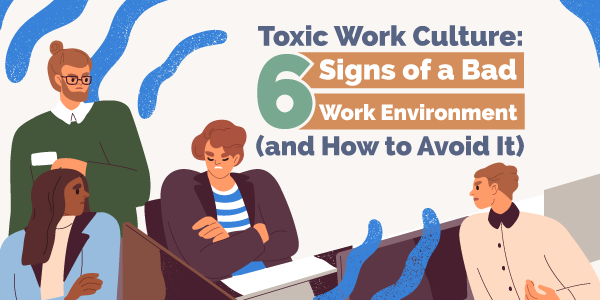
There are different reasons why employees either thrive or fail in any type of organization.
One of the biggest contributors is the workplace environment. If the workplace environment has a supportive team and accessible resources, chances are employees will prosper in their jobs.
The opposite scenario will, at best, cause employees to fall short in terms of productivity, and at worse, trigger burnout. The latter could then spell a high turnover rate, which is a must-avoid scenario for all businesses.
These days, organizations either observe office-based or work-from-home (WFH) arrangements. Some have chosen to follow a hybrid model, with both physical and remote work setups in place. Here, it’s important to note that a bad work environment is not limited to physical offices.
Even if you’re running a mostly digital workplace, it’s still possible for a bad workplace environment to exist—and your WFH employees are nonetheless susceptible to it.
Our infographic will cue you in on how a toxic work culture looks like and what to do about it.

What is a Toxic Work Culture?
It’s normal to have a bad day at work. It’s even okay to feel like you went through an entire quarter in low spirits because you suspect you delivered mediocre output. These emotions don’t equate to being in a toxic work environment.
However, if you’re under relentless stress, day in and day out, for things that are beyond your control, chances are your work environment is to blame.
The ideal workplace should make you feel that you’re doing a job that has value, alongside people that share your beliefs and for goals that you can get behind with. Once you get detached from these prerequisites for a fulfilling career, it’s time to reassess the work culture at play in your organization. Be wary of psychosocial hazards.
According to a study from EVERFI, Inc., 54% of respondents share that stress and high rates of toxic cultures are common in the workplace. And 53% of them believe their organization lacks initiatives to combat workplace toxicity. These numbers are enough to convince leaders and managers to look into workplace culture more closely.
That’s true even in remote work set-ups. Such arrangement does not exempt an organization from workplace toxicity. It can even exacerbate the situation, making possible micromanagement that borders on harassment, hostility manifested in online interactions, and compromised work-life balance.
Signs You Are in a Bad Work Environment
There are common signs that will alert you that your workplace has gone toxic. It’s important to be wary of these manifestations.
1. Bad or unclear communication
Projects are disseminated without clarity and cohesion. The results are outputs that fall below company standards. And once it’s time to trace where things went wrong, people start to point fingers. This utter lack of accountability from management to rank-and-file employees is a telltale sign that there’s something wrong with how things are communicated and done in the workplace.
2. Gossipy behavior
Be wary of the emergence of cliquish groups, too. While there’s nothing wrong with a small collection of people finding each other within a big organization per se, it’s inevitable for these groups to become exclusive. Their pastime becomes alienating those outside the group and gossiping about everyone else’s business. When this happens, the structure of a toxic workplace may begin to form. This results in resentment between colleagues.
3. Poor leadership and management
There’s also poor management to look into. If you have leaders who are quick to accept credit for a job well done and just as quick at pointing fingers for mishaps, you probably have a cycle of awful leadership tutelage.
Think of one bad manager as the direct consequence of a bad superior responsible for the former’s advancement in the corporate ladder. For this cycle to see an end, you need to reevaluate how your leaders are made and what the organization expects of them.
4. High employee turnover
One of the worst possible signs of a toxic work environment is a high turnover rate. Employees won’t resign without any justifiable reason—and a workplace environment that threatens their wellbeing is enough of a reason. Here, your business risks facing financial losses from the investments you’ve made in scouting and training every employee.
5. Micromanagement
Micromanagement is a sign of incompetent leadership. Instead of delegating and trusting subordinates to deliver quality and on-time output, managers might be prone to wasting their time breathing down employees’ necks.
This leadership style paves the way for distrust, which is counterproductive to what leadership is all about. If leaders can’t trust their subordinates, the latter may develop issues about trusting their leaders, too.
6. Minimal trust
Minimal trust can manifest in two ways:
- The management does not trust their employees to do their work within the given time so they closely monitor all movements, and ask for updates persistently.
- The employees believe that the management does not have their best interest in mind, and their growth and development in the company are stunted.
This back and forth between the management and employees will be a breeding ground of toxic work culture and bad work environment.
Effects of a Bad Work Environment on Your Employees
- Your employees are the first to suffer from a toxic work environment. The initial effect will be a loss of motivation. Any person who feels like they are not afforded the respect and protection they deserve will lose focus and interest in the job they’re supposed to do.
- Without motivation, output suffers. Instead of doing work that adds value to the organization, employees might turn into time-wasting activities like gossiping with each other or using company resources and absent-mindedly checking out non-work-related content, such as memes, online.
- A toxic work culture can also cause an employee to suffer from anxiety and depression. For instance, one who’s delivering all of their job requirements and more without getting the appreciation they deserve might experience a downward spiral of diminishing self-esteem. This can easily lead to burnout.
- Burnout, in turn, can trigger not just psychological ailments but physical maladies too. Stress affects our immune system, after all. And an employee who often gets the flu might be an overworked and underappreciated member of your team. They will be more prone to missing work. Once again, that will cost your business. According to Integrated Benefits Institute, missed workdays due to illness cost employers $530 billion a year.
Key Solutions to a Bad Work Environment
To address a bad work environment, it’s important to have a clear stance against toxic behaviors. Show everyone, from top to bottom, that bullying, harassment, or any other form of toxicity will not be tolerated. It’s also important to look into how things are done within the organization. Those that need to be revamped, because they add to a culture of toxicity, should be revamped.
For changes to mean something, input from employees must be solicited. Employees know what’s happening on the floor and they have valuable insights to share.
It’s also crucial to prioritize employees’ well-being. Happy employees will find no reason to spread toxicity. That means a happy organization, too. And if someone threatens that sense of peace and balance, don’t hesitate to let that person go. No matter how talented they seem to be.
Whether you’re hands-on with HR and people management or you’ve outsourced the job to a recruitment agency in the Philippines, maintaining a healthy office culture is your responsibility. The same rule applies whether your office is location-based or digital.
Turn Around a Toxic Work Culture
There’s no excuse for a toxic work environment. Your employees deserve to deliver their job in a place where they feel valued, respected, and supported. If those requirements are present, they will feel at ease and at peace with the work they do. That results in improved productivity, which can only be good for business.
If you notice any of the signs of a toxic office culture listed above in your workplace, do not sweep the problem under the rug. Approach the situation head-on. The last thing you want to happen is to let something seemingly inconsequential but undeniably toxic grow into something unmanageable. In such a case, your employees will suffer. So will your business.
For your HR and people management needs, Manila Recruitment could be of help with its top-notch services.













